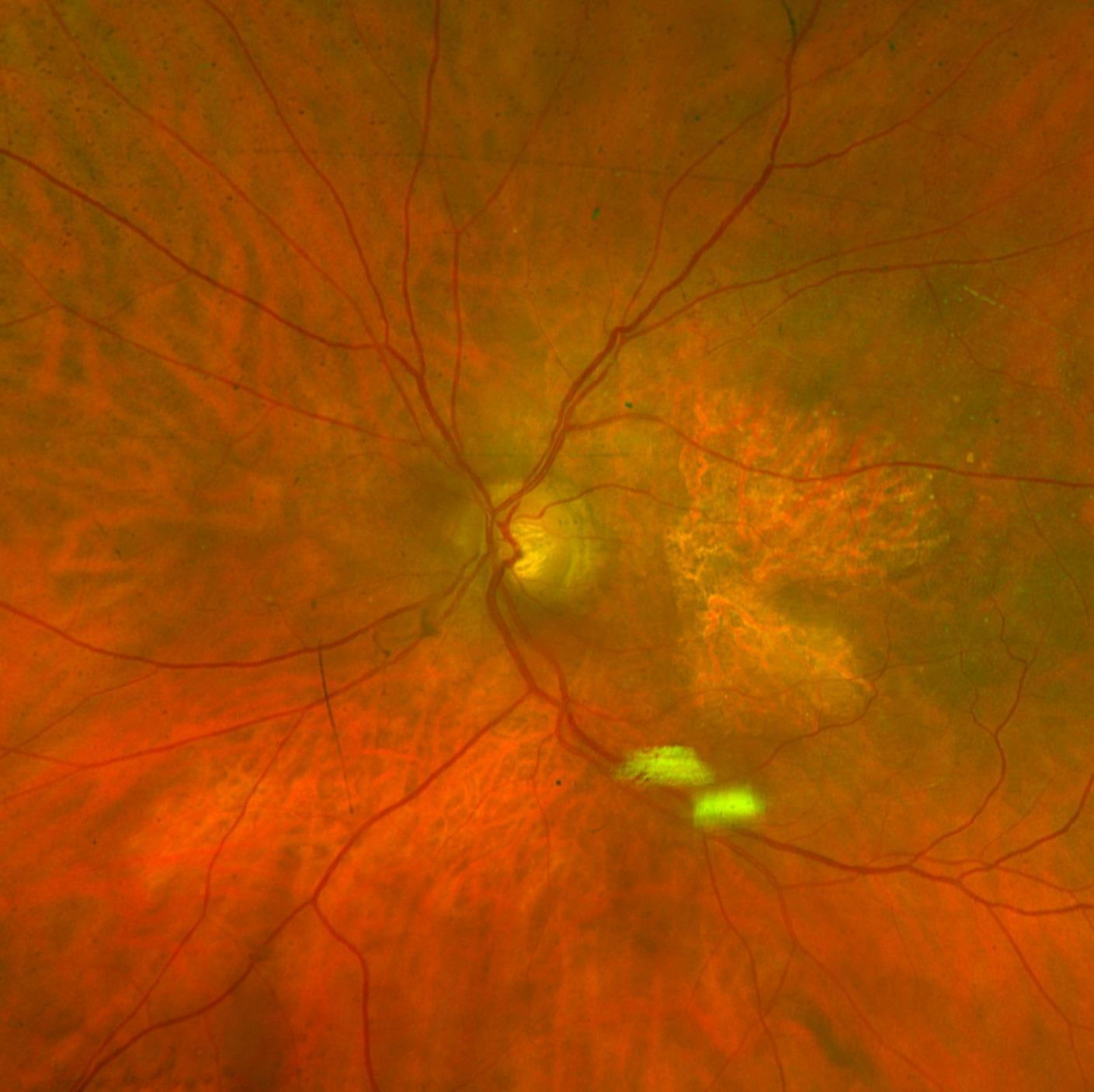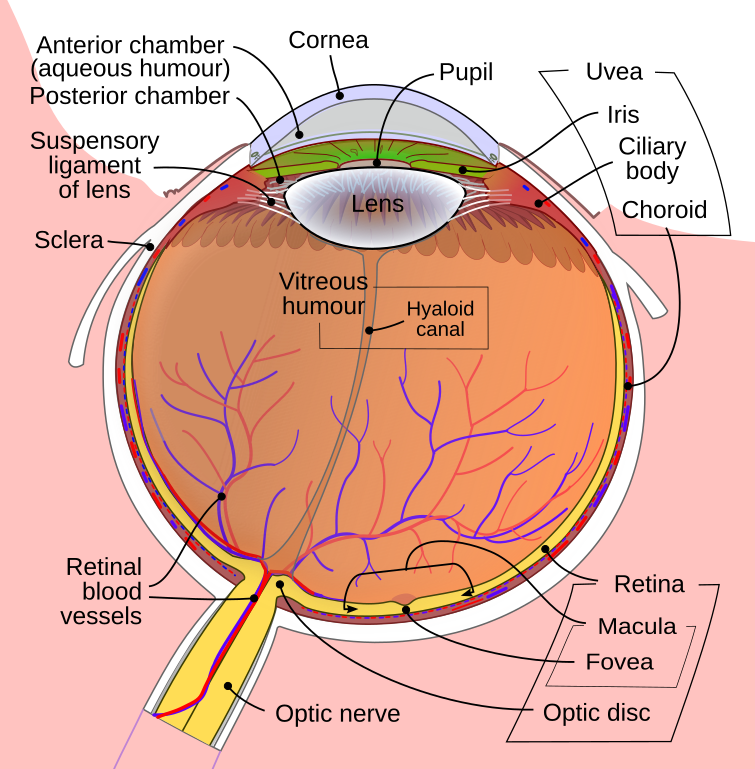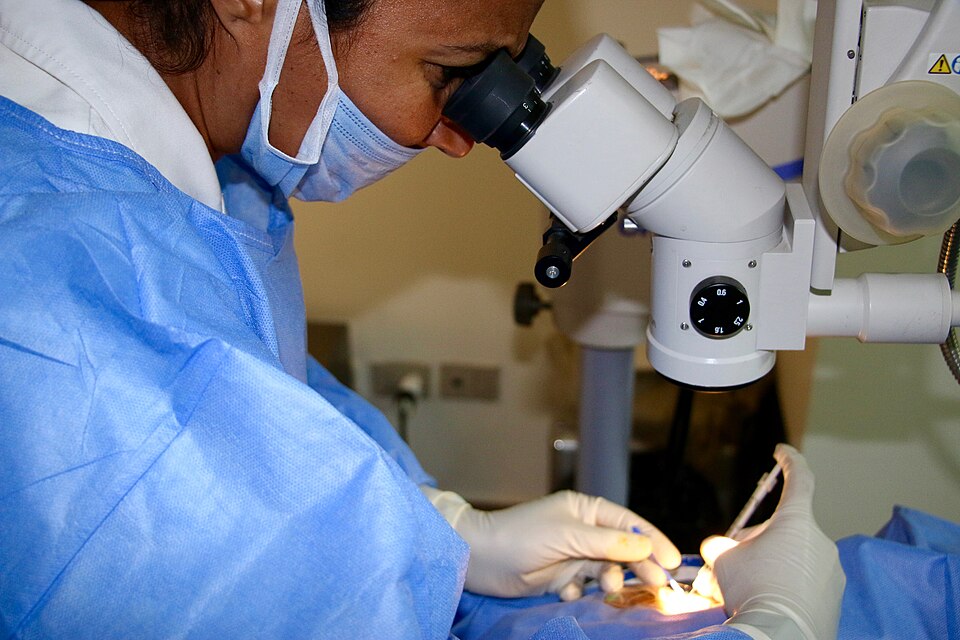SYFOVRE
also known as Pegcetacoplan
Last updated August 21, 2025
Medical information on this page is for educational purposes only and is not a substitute for professional medical advice, diagnosis or treatment.
See our Terms & Conditions and Consent for Telemedicine for details.




Overview
SYFOVRE (pegcetacoplan) is a prescription eye injection used to slow the growth of geographic atrophy (GA), an advanced form of dry age-related macular degeneration (AMD). The medicine blocks complement C3, a part of the immune system linked to ongoing damage in GA, and it is given inside the eye by a trained specialist. 1
GA harms central vision over time and may cause blind spots that slowly get larger, making reading, driving, and face recognition harder as months and years pass. 2
The aim of SYFOVRE is to slow GA growth, not to cure GA or restore lost cells. Many people continue daily activities with help from lighting, magnifiers, and regular eye checkups. Your retina team will use imaging to measure the atrophy area and watch for changes over time so you can understand progress and plan next steps.
How the Procedure Works & Options
SYFOVRE is given as an intravitreal injection (medicine placed into the gel of the eye). At each visit, the eye is numbed, cleaned, and held open with a small lid holder; a very fine needle delivers 0.1 mL into the vitreous. Dosing is typically once every 25 to 60 days (about monthly or every other month), and your doctor will tailor the plan to your eye and schedule. 3
Intravitreal injections are common, in-office procedures with steps designed to keep you comfortable and reduce risk. 4
- Visit flow: check-in and vision test → numbing and cleaning → brief injection → post-injection check → go home the same day.
- What you may feel: mild scratchiness or a sensation of something in the eye for a day or two; artificial tears can help.
- Scheduling choices: monthly may offer slightly more effect for some, while every-other-month reduces visit burden; both schedules were studied.
Who Is a Candidate?
SYFOVRE is approved for adults with GA secondary to AMD. People should skip an injection if they have an active eye infection, active inflammation inside the eye, or a known severe allergy to the drug or its ingredients. Your doctor will screen for these issues before treatment. 5
In two large clinical trials (OAKS and DERBY), pegcetacoplan slowed GA growth compared with sham (no drug) across monthly and every-other-month dosing. 6
- Good signs for candidacy: confirmed GA from AMD, ability to return for regular visits, and willingness to report any new symptoms right away.
- Things to discuss: GA location (center-involving or not), other eye diseases, prior injection history, and help with rides or reminders for appointments.
Enter your details below to check your suitability for this treatment
Suitability Level
Recommendation
Cost and Price
SYFOVRE is given in the clinic by your eye doctor, so coverage in the United States is often through Medicare Part B or medical insurance rather than a retail pharmacy benefit. Exact costs depend on your plan, deductibles, and coinsurance, and the clinic can help check benefits before you start. 7
Medicare also explains how certain outpatient prescription drugs are covered under Part B when given by a doctor as part of a service. 8
- Tip: Ask the retina clinic to run a benefits check and to explain any expected out-of-pocket amount before your first injection.
- Extra help: If you have supplemental insurance, it may reduce your share; ask about any manufacturer support programs if you meet their criteria.
Benefits and Limitations
Benefits: In OAKS and DERBY, SYFOVRE slowed the rate of GA growth versus sham. Even though the monthly change is modest, the effect builds over time, which may help people keep useful vision for tasks like reading and recognizing faces for longer. 9
Limitations & Risks: SYFOVRE does not cure GA and does not replace low-vision tools. Risks of any intravitreal injection include infection (endophthalmitis), inflammation, bleeding, and temporary eye pressure rise. The label also warns about rare but serious retinal vasculitis and/or vascular occlusion; call urgently for severe pain, many new floaters, big redness, or sudden vision drop after an injection. 10
Recovery and Long-Term Care
Most people go home right after the injection. A scratchy feeling, mild tearing, or light redness is common for a day or two and often improves with artificial tears. Seek urgent care for strong pain, worsening redness, light sensitivity, many new floaters, or sudden vision changes. These can be signs of infection or inflammation that need quick treatment. 11
Your care team will set a return date (about every 4–8 weeks) to check vision, review imaging, and give the next dose if appropriate. 12
- At home: avoid rubbing the eye on the day of the shot; use any drops as directed; and keep a list of questions for your next visit.
- Over time: tell your doctor about any new distortions, wavy lines, or a gray spot in the center—these can hint at wet AMD and need fast attention.
Latest Research & Innovations
Two large phase 3 trials, OAKS and DERBY, tested pegcetacoplan versus sham and showed slower GA growth with both monthly and every-other-month dosing over 24 months. These results supported FDA approval and guide today’s clinic use. 13
Researchers then continued follow-up in the GALE extension to look at longer-term safety, anatomy, and visual function up to 36 months, with published 12-month GALE results now available in a peer-reviewed journal. 14
- Why this matters: GA grows slowly, so multi-year data help show whether benefits persist and which patients may gain the most over time.
- What’s next: Ongoing studies are exploring how GA location (center-involving or not) and visit patterns affect outcomes, and how to combine care if wet AMD appears.
Recently Published in Peer-Reviewed Journals
American journal of ophthalmology
September 1, 2025
Visual Acuity and Quality of Life Outcomes With Pegcetacoplan Treatment: A Post Hoc Analysis From the OAKS and DERBY Trials.
Chiang A, Davis M, Stevens W, et al.
American journal of ophthalmology
August 1, 2025
Erratum to "Visual Function Benefit After Treatment With Pegcetacoplan: Microperimetry Analysis From the Phase 3 OAKS Trial," [Am J Ophthalmol 2025; 273:119-129].
Chakravarthy U, Schwartz R, Guymer RH, et al.
Retina (Philadelphia, Pa.)
May 6, 2025
Silicone oil microdroplets from syringes with intravitreal anti-vascular endothelial growth factor and complement inhibitor injections.
Wei L, Lee E, Fan X, et al.
Next Steps
If you have GA—or new blind spots or trouble reading—schedule a visit with a retina specialist (ophthalmologist). They will confirm the diagnosis with imaging, explain choices like SYFOVRE, check for other causes of vision changes, and build a plan that fits your goals and routine. 15
Also learn about lighting tools, magnifiers, and low-vision services that can help with everyday tasks as GA progresses. 16
- How Kerbside helps: We can connect you with the right expert for a medical education consult so you feel ready for your clinical appointment (this is not medical care or a physician-patient relationship).
- Bring to your visit: your medication list, a record of symptoms, any prior eye images, and questions about dosing frequency, safety, and costs.
Trusted Providers for SYFOVRE

Dr. Emily Eton
Specialty
Retina/Vitreous
Education
Harvard Medical School

Dr. Grayson Armstrong
Specialty
Retina/Vitreous
Education
Ophthalmology

Dr. Jose Davila
Specialty
Retina/Vitreous
Education
Retina/Vitreous Surgery

Dr. Nicholas Carducci
Specialty
Retina/Vitreous
Education
University of Pennsylvania Perelman School of Medicine